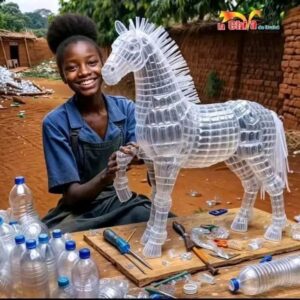Sculpting a Greener Future: How One Woman and a Team of Innovators are Combating Climate Change with Plastic Bottle Creations
Mariam’s Journey Began A few Years Ago When She Noticed The Growing Piles Of Plastic Waste In Her Neighborhood.

Uganda Today Edition: Sculpting a Greener Future: How One Woman and a Team of Innovators are Combating Climate Change with Plastic Bottle Creations
In a world increasingly choked by plastic waste, innovative solutions are emerging from unexpected corners. One such beacon of creativity and environmental consciousness is Mariam Nakato, a Ugandan artist who has turned discarded plastic water bottles into stunning Zebra animal sculptures. Her work is not only a testament to artistic ingenuity but also a powerful statement on environmental conservation and the fight against climate change.
A Unique Artistic Vision
Mariam’s journey began a few years ago when she noticed the growing piles of plastic waste in her neighborhood. The sight of these non-biodegradable materials littering the streets and clogging waterways deeply troubled her. As an artist, she felt compelled to act. But instead of merely protesting against the waste, Mariam saw an opportunity to create something beautiful out of the problem.
She started by collecting plastic water bottles from local dumpsites and households. Her early experiments involved cutting, shaping, and assembling these bottles into various forms, but it was her zebra sculptures that captured the public’s imagination. Each sculpture, painstakingly crafted, showcases the striking black and white stripes of zebras, symbolizing the delicate balance of nature that plastic waste threatens to disrupt.
“I wanted to create something that would not only raise awareness about the environmental crisis we are facing but also inspire others to think creatively about how we can address it,” Mariam explains. “The zebra, with its distinct and contrasting colors, felt like the perfect metaphor for the urgency of this issue.”
Innovation Meets Conservation
Mariam’s work has inspired a growing movement in her community, encouraging others to see waste not as trash but as a resource. Her success has also shone a light on other innovators who are tackling the plastic problem in equally creative ways.
Among these innovators is a group of young men from the same region who have developed a method for creating building bricks from plastic water bottles. Like Mariam, they were motivated by the sheer volume of plastic waste around them and the lack of affordable housing materials in their community.
Their process involves filling plastic bottles with sand, which are then compacted to form sturdy, durable bricks. These bricks have been used to build houses, community centers, and even schools, providing a low-cost, eco-friendly alternative to traditional construction materials. The bricks are not only strong and reliable but also offer excellent insulation, making them ideal for Uganda’s diverse climate.
The Power of Plastic Repurposing
Both Mariam’s sculptures and the brick-making initiative demonstrate the transformative power of repurposing plastic waste. By diverting plastic bottles from landfills and waterways, these projects significantly reduce the environmental footprint of the community. The benefits are manifold: reducing pollution, conserving resources, and even combating climate change by lowering the demand for new plastic production, which is a significant source of greenhouse gas emissions.
Moreover, these initiatives contribute to a circular economy, where materials are reused and recycled rather than discarded. This not only conserves resources but also creates economic opportunities. Mariam’s sculptures, for instance, have attracted attention from art collectors and environmental organizations alike, providing her with a sustainable income while spreading her message. Similarly, the brick-makers have been able to sell their products, contributing to the local economy and providing affordable housing solutions.
A Call to Action
The success of these projects underscores the effectiveness of removing plastic bottles from the environment and repurposing them in innovative ways. Plastic waste is one of the most pressing environmental issues of our time, contributing to pollution, harming wildlife, and exacerbating climate change. Yet, as Mariam and the brick-makers have shown, the solution may lie in our ability to rethink and reimagine the materials we use.
Their work is a powerful reminder that innovation, creativity, and a commitment to environmental stewardship can lead to solutions that benefit both people and the planet. As Mariam puts it, “If we can turn waste into art and buildings, we can turn the tide on climate change. It’s about seeing possibilities where others see problems.”
In the fight against climate change, every effort counts, and every bottle saved from the landfill is a step towards a more sustainable future.









